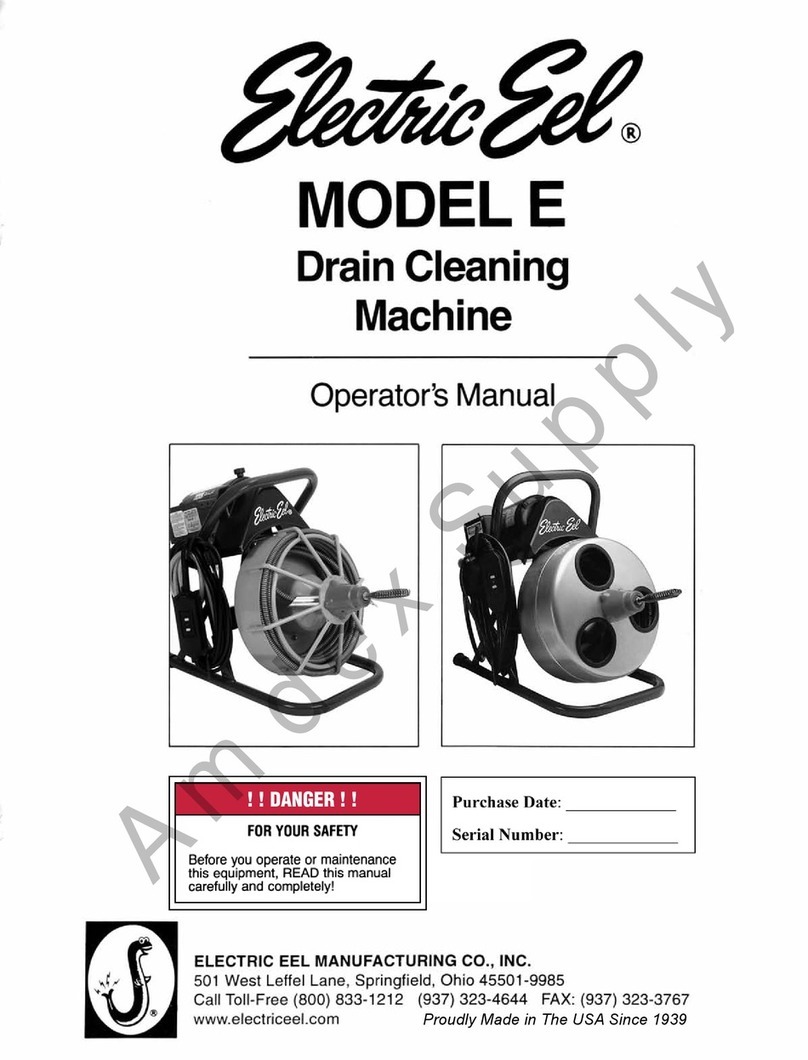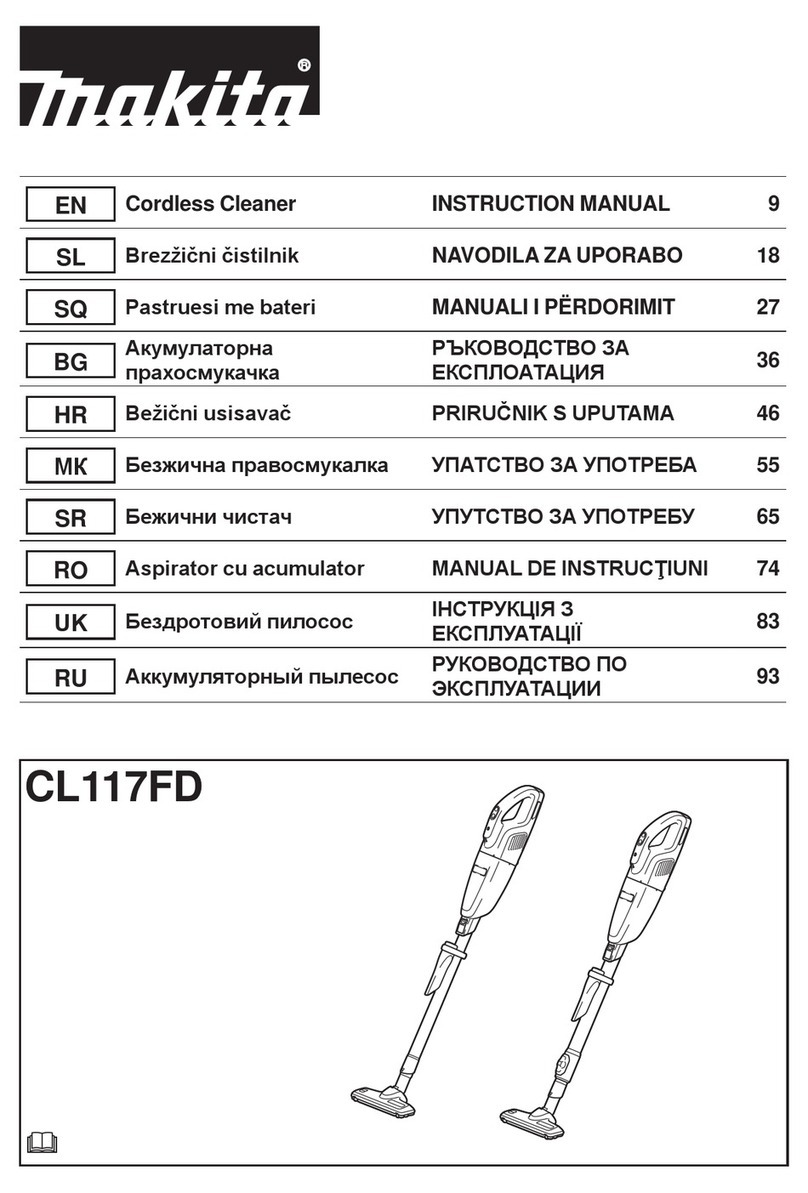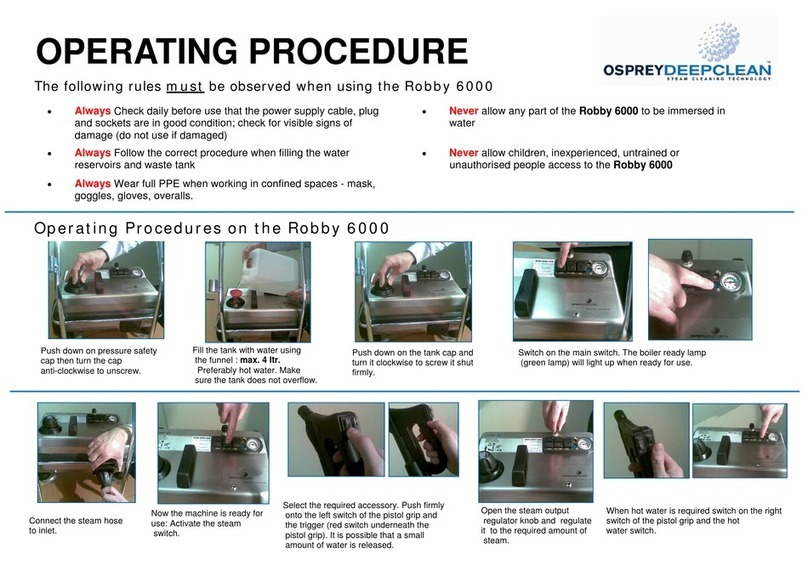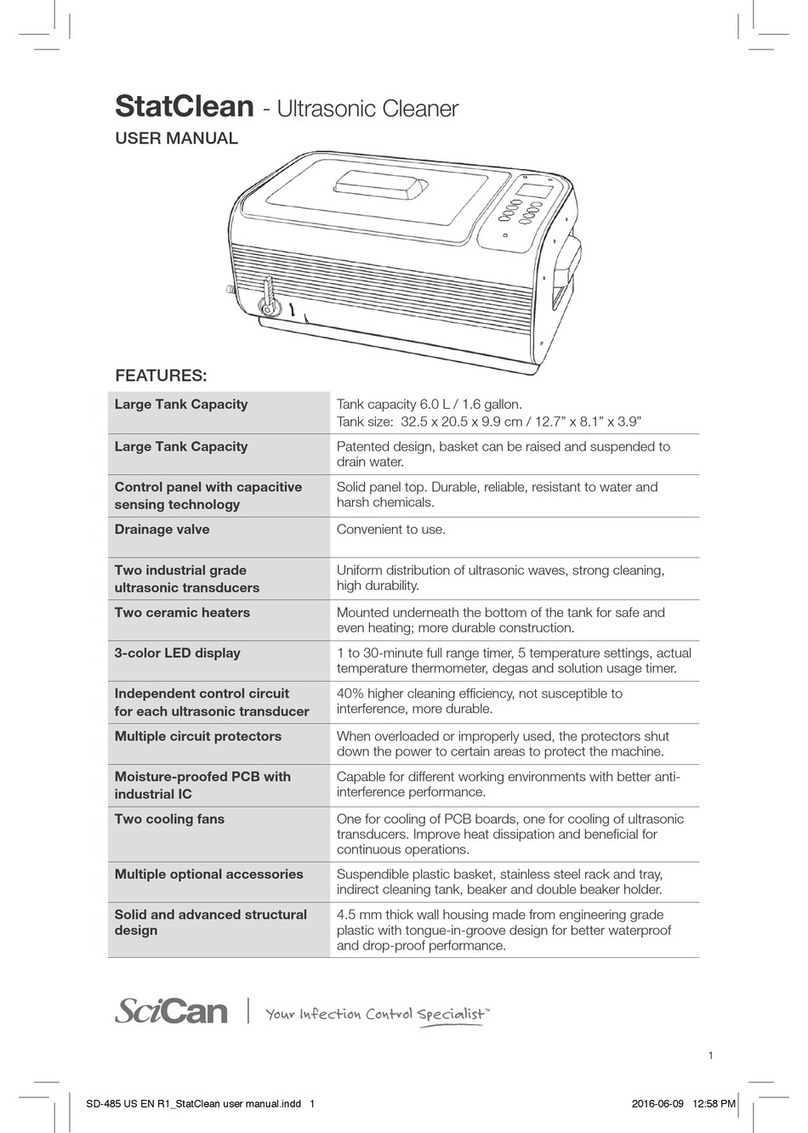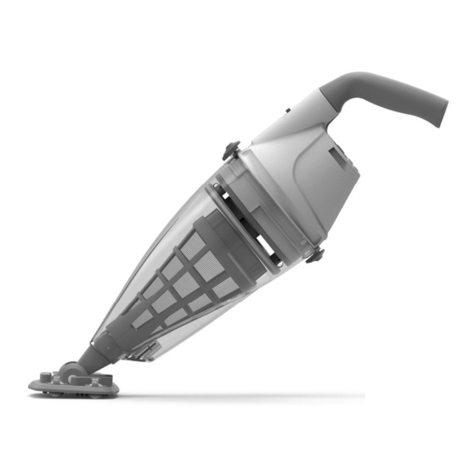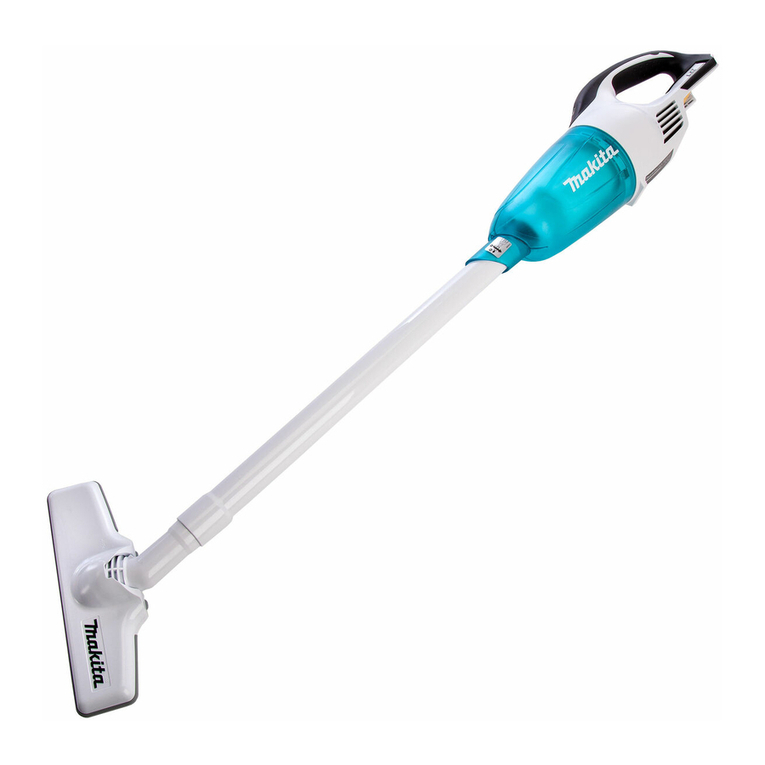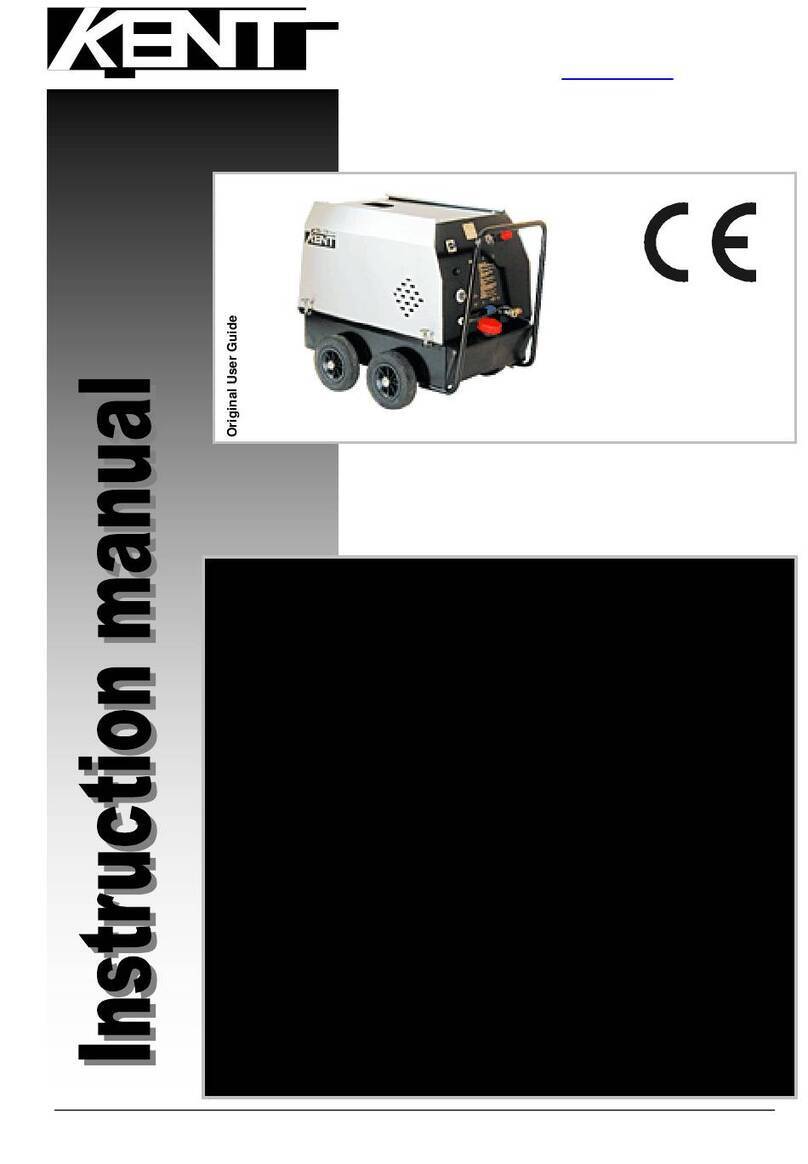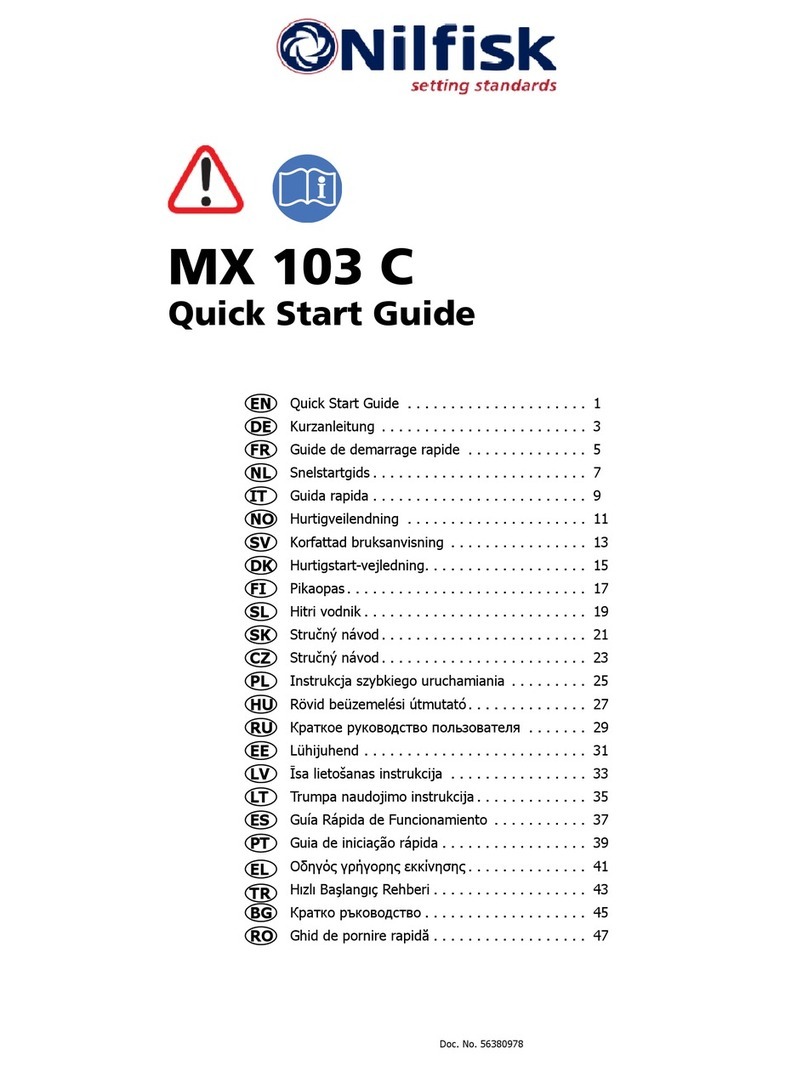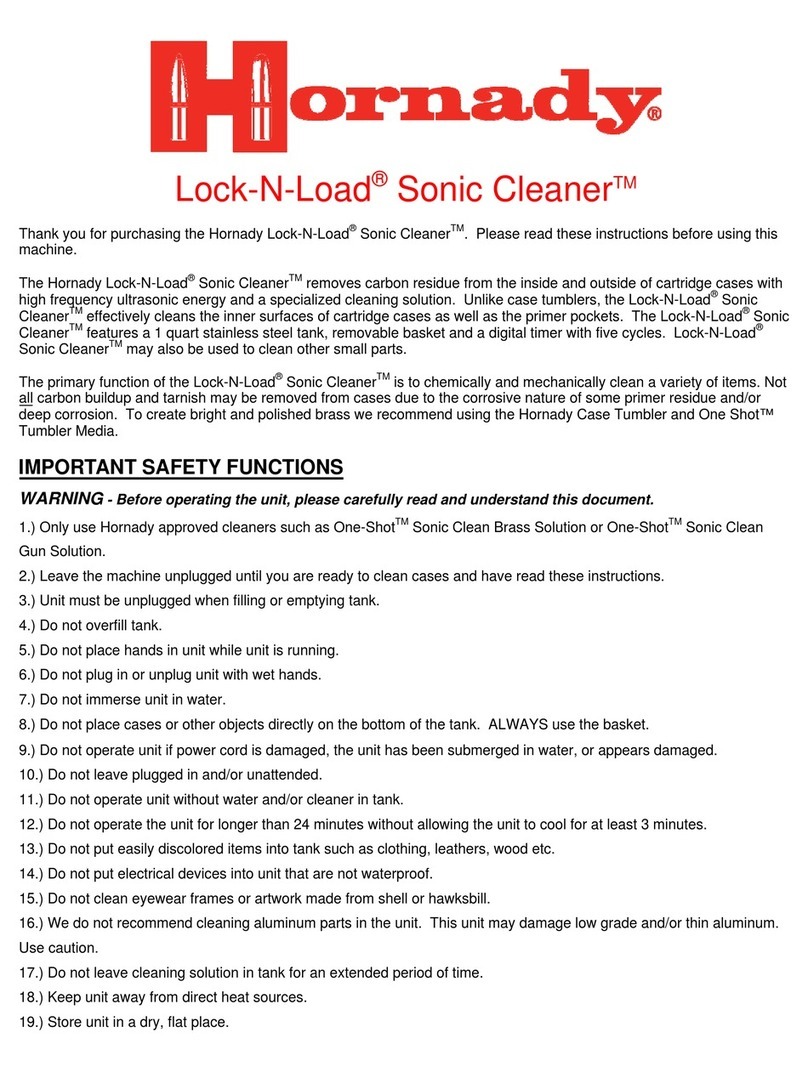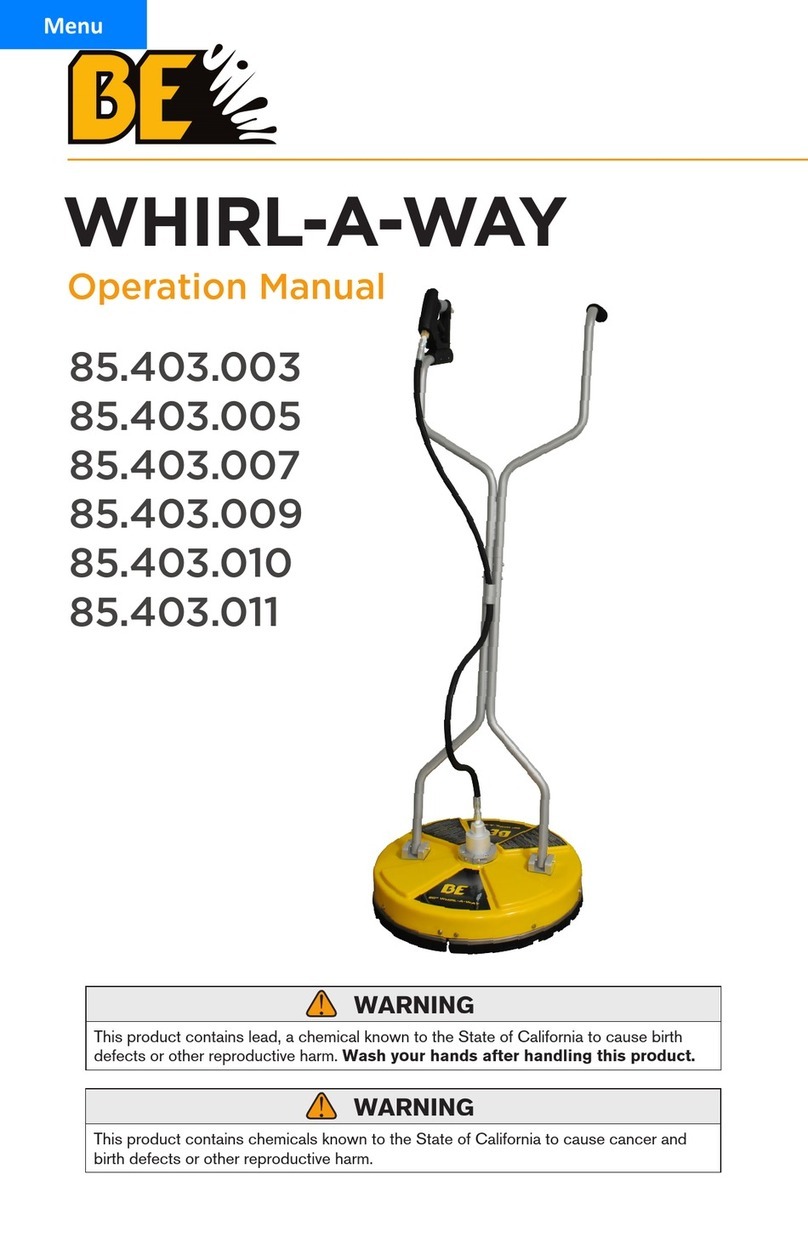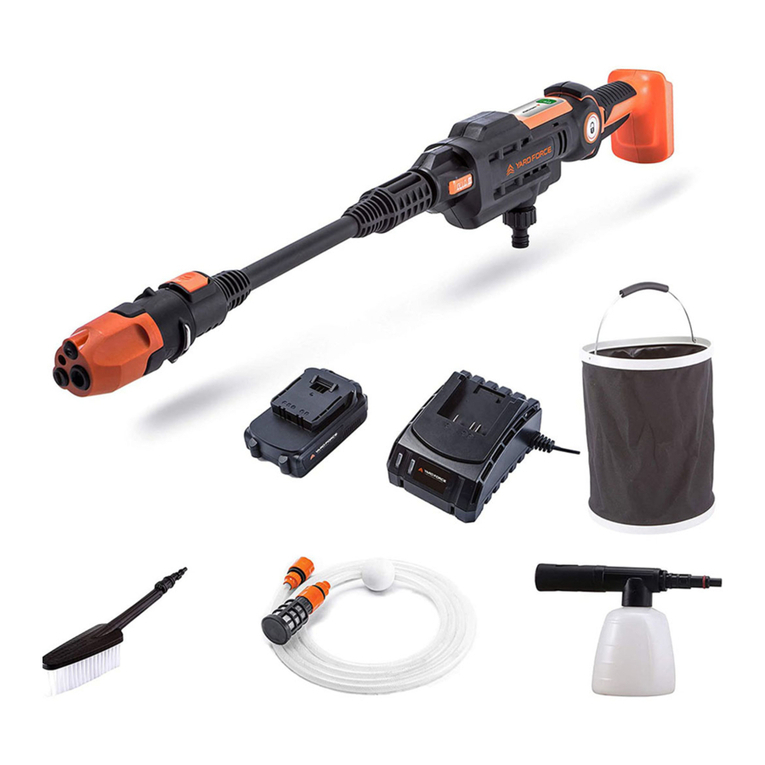Electric Eel RF User manual

MODEL RF
Drain Cleaning Machine
Operator’s Manual
ELECTRIC EEL MANUFACTURING CO., INC.
501 West Leffel Lane, Springfield, Ohio 45501-9885
Call Toll Free (800) 833-1212 (937) 323-4644 FAX: (937) 323-3767
www.electriceel.com Proudly Made in The USA Since 1939
FOR YOUR SAFETY
Before you operate or
maintenance this equipment,
READthis manual carefully and
completely!
!! DANGER !!
The Electric Eel Model RF Drain
Cleaning machine is a professional
quality sewer and drain cleaning piece of
equipment. This machine is specifically
designed for cleaning 3” to 6” drain lines
up to 100 feet in length and features a
two-way auto cable feed for ease of
operation. A cable guide spring also
keeps hands off rotating cable near the
machine.

2
STANDARD EQUIPMENT
Electric Eel Model RF comes complete with:
•RF unit with auto cable feeder
•Cable guide spring
•100 ft. of 3/4” Tri-Max Cable
•Set of 3cleaning tools including:
!A-1DC starting drill
!U-3H grease tool(U-cutter)
!HDD-3S root saw
•1-FLSC1SC2 flexible leader
•SC-18 spanner wrench
•Tool bag to hold cleaning tools
SAFETY
INSTRUCTIONS
The following safety rules for operating
Electric Eel’s Sewer and Drain Cleaning
equipment MUST be read carefully
before operating this machine.
GENERAL SAFETY
DANGER
TO PREVENT SERIOUS BODILY
INJURY:
1. ALWAYS wear HEAVY leather
gloves and safety glasses when
operating equipment.
2. Place machine cable guide spring
at pipe opening. NEVER have
exposed cable.
3. DO NOT wear loose clothing or
jewelry while operating this
machine.
DANGER
To prevent serious injuries including:
•Shock, electrocution or burns due
to improper grounding.
•Serious injuries to body, limbs or
hands and feet due to cables that
twist, kink and break.
•Eye injuries caused by loose cable,
thrown debris or splashed water.
READ SAFTEY INFORMATION
THOROUGHLY!

3
4. Use foot switch to operate machine
while keeping good footing and
balance at all times. DO NOT
OVERREACH.
5. Machine, foot actuator and cable
should be operated by one person
only. Additional personnel in the
working area should observe all
safety instructions.
6. ALWAYS keep all guards in place
during operation.
7. ALWAYS wear rubber-soled non-
slip shoes.
8. ALWAYS avoid direct contact of
skin, facial area and especially
eyes with drain water. Chemical
compounds used in drains can
result in serious burns and other
injuries.
9. Replace fittings, cables and any
rotating parts as soon as they
become visibly worn. Replace any
cables which become fractured,
bent, kinked, or any other damage
occurs.
10. NEVER attempt to service
equipment beyond the
recommendations of the operat-
ing instructions. All other
servicing should be referred to
qualified service personnel.
11. To maintain safe operation, use
only identical replacement parts
and cables from Electric Eel.
12. ALWAYS keep clear of rotating
cages/drums, shafts, pulleys,
belts, or other rotating parts.
GENERAL SAFETY -
ELECTRICAL
DANGER
TO PREVENT SERIOUS BODILY
INJURY AND TO AVOID DANGER
FROM ELECTRICAL SHOCK:
1. ALWAYS use a Ground Fault
Circuit Interrupter (GFCI) with a
properly grounded outlet for all
electrical cords, connections, and
parts as installed by factory and
DO NOT make any alterations.
2. NEVER use machine in damp or
wet conditions.
3. NEVER expose machine to rain.
4. THE USER SHOULD NEVER
ATTEMPT TO SERVICE THE
ELECTRICAL COMPONENTS.
For safety reasons, all electrical
replacement components should
be installed by a qualified
electrician.
5. ALWAYS disconnect the
power cord from the electrical
source before making any
adjustments or changes to
power units.
6. If an extension cord is used, the
power source MUST be equipped
with a Ground Fault Circuit
Interrupter (GFCI) and properly
grounded.

4
7. Only use 10/3 or larger three-wire
extension cords with three-prong
grounding plugs and three-pole
receptacles.
8. When using an extension cord
outdoors, only use those intended
for outdoor use. (Indicated on
cord by suffix “W-A” after cord
type.)
THE GROUND FAULT CIRCUIT
INTERRUPTER
(GFCI)
This machine is equipped with a Ground
Fault Circuit Interrupter (GFCI) which is
designed to prevent a serious electrical
shock. This device should be tested on
the jobsite before putting the machine
into operation as follows:
1. To ensure protection against
electric shock, test the device
before each use. When test button
is pushed in, the indicator light
should go off. Reactivate the
device by pushing the reset button
in. If the indicator light goes on,
the device is ready for use. DO
NOT use the device if the indicator
light does not go on when reset or
if the indicator light remains on,
when the test button is pushed in.
2. This device does not guard against
electric shock resulting from
defects or faults in any wiring
supplying power to this device, or
from contact with both circuit
conductors.
GENERAL SAFETY–
ROTATING CABLES
AND EQUIPMENT
DANGER
TO PREVENT SERIOUS BODILY
INJURY AND TO AVOID DANGER
FROM ROTATING CABLES AND
EQUIPMENT:
1. USE CAUTION AT ALL TIMES.
Cable can twist or kink and
cause serious injury. Fingers or
other body parts can be caught
in rotating parts.
2. NEVER handle the rotating
cable.
3. NEVER handle any cable
under tension. Relieve all
tension build up before
attempting to handle cable.
4. NEVER operate machine without
cable guide spring in place.
5. Use feeder to advance or retract
cable with motor switch in
FORWARD position for ALL
cleaning operations.
6. DO NOT continue to operate
machine when cleaning tool
becomes stuck in obstruction.
Excess torque on a cable
could cause it to fracture.
(Refer to operating instructions
to free cleaning tool.)

5
7. NEVER force a tool and cable into
a pipeline blockage. This may
overload the cable or tool and
cause it to fracture.
8. ALWAYS wear HEAVY leather
gloves and safety glasses when
operating machine.
9. Use correct tool for the job or
application. Check the tool
listing for the correct tool and
line size.
10. To maintain safe and efficient
operation, thoroughly clean all
cables with water after use.
Acids in the drain and sewer
lines attack and deteriorate the
metal of the cables and tools.
Deterioration will cause
weakness in cable and tools and
result in fracture or breakage. A
light coating of oil applied to the
cable before storing will help
prevent rusting and premature
failure.
11. Replace all cables and tools that
become deteriorated, worn,
kinked, bent, or any other
damage that occurs.
MACHINE SET-UP
DANGER
TO PREVENT SERIOUS BODILY
INJURY:
NEVER USE ANY CABLE IN THIS
MACHINE OTHER THAN ELECTRIC
EEL 3/4” DIAMETER CABLE.
DISCONNECT POWER CORD
BEFORE ANY SET UP OR
MAINTENANCE IS ATTEMPTED.
This machine comes completely
assembled except for the cable guide
spring. Simply connect cable guide
spring to feeder with snap pin. (See
Figure #1)
Figure 1

6
TOOL SELECTION
It is important to choose the proper
cleaning tool for each cleaning
application. See the tools outlined
below.
Standard Tools Included with the
Model RF Kit:
1. SC-18 Spanner Wrench
2. U3H Grease Tool (U-Cutter)
3. HDD-3S Root Saw
4. A-1DC Starting Drill Tool
5. 1-FLSC1SC2 Flexible Leader for
Negotiating P-Traps
OPERATING
INSTRUCTIONS
DANGER
OPERATOR MUST BE
THOROUGHLY FAMILIAR WITH
ALL SAFETY INSTRUCTIONS
BEFORE OPERATING
EQUIPMENT.
FOR AUTOMATIC CABLE
FEEDER
1. WITH POWER OFF, attach a
small spear-type cleaning tool to
the end of the cable. This tool
will enable you to bore a starter
hole in the obstruction, allowing
backed-up water to drain.
NOTE: The flexible leader should
be used with the A-1DC Starting
Tool when negotiating P-Traps or
severe bends in the line.
2. Place machine cable guide spring
at pipe opening. NEVER have
exposed cable.
3. Position foot actuator for easy
operator accessibility.
4. Make sure switch is in
FORWARD position. Run
machine in FORWARD at all
times during cleaning operation.
5. Place one HEAVY leather gloved
hand on the cable guide spring
to control cable as it rotates
inside; and use other hand to
work the feeder control lever.
DANGER: Operator must keep one
HEAVY leather gloved hand on
cable guide spring at all times
during operation.
1
234
5

7
6. WITH POWER ON, in order to
feed cable, the operator must
move the feeder control lever from
NEUTRAL (the position midway
between FORWARD and REVERSE)
to the FORWARD position, while
depressing the foot actuator. (See
Figure #2 for FORWARD feeder
position)
Figure 2
NOTE: The speed at which the cable
is fed initially can be controlled by
moving the control lever toward
FORWARD to increase speed and
moving back toward NEUTRAL to
slow speed.
NOTE: If the feeder control lever is
initially put in FORWARD but the
cable is not advancing, then turn the
cable tension knob in a clockwise
direction until the cable begins to
advance. (See Figure #3)
DO NOT over-tighten cable tension
knob as it may damage feeder
bearings.
Figure 3
7. Continue to automatically feed
cable until obstruction is met.
When cable begins to drag or
rotation becomes difficult, move
the lever to the NEUTRAL
position and allow tool to cut
away at the obstruction. (See
Figure #4 for NEUTRAL feeder
position)
Figure 4
DANGER: NEVER force the cable
or tool into the obstruction. Choose
the proper feeding speed in order to
give a smooth cutting action.

8
8. If tool becomes hung up in the
obstruction, move control lever to
the REVERSE position to back
out tool. (See Figure #5)
Figure 5
9. After tool has been removed
from obstruction, move control
lever back to the FORWARD
position and continue to work
through obstruction.
10. To retrieve cable from line,
move control lever to the
REVERSE position (while
continuing to operate cage in
forward rotation) and cable will
back out of line and feed into
cage.
NOTE: It is recommended to use a
continuous flush of water to clean
tool, cable and sewer line as cable is
retrieved.
11. When tool is close to cleanout
opening, return Control Lever to
NEUTRAL position, place switch
in OFF position, release foot
actuator and allow machine to
come to a complete stop.
DISCONNECT POWER CORD.
12. Pull remaining cable and tool
from drain line and hand-feed
cable back into machine.
MAIN SEWER OR SEPTIC
TANK OVERUN
Operator should determine the
approximate distance from cleanout
opening to the main sewer or septic
tank. Overrunning cable into these
areas can cause cables to twist or
knot-up preventing their retrieval.
Table of contents
Other Electric Eel Ultrasonic Jewelry Cleaner manuals
